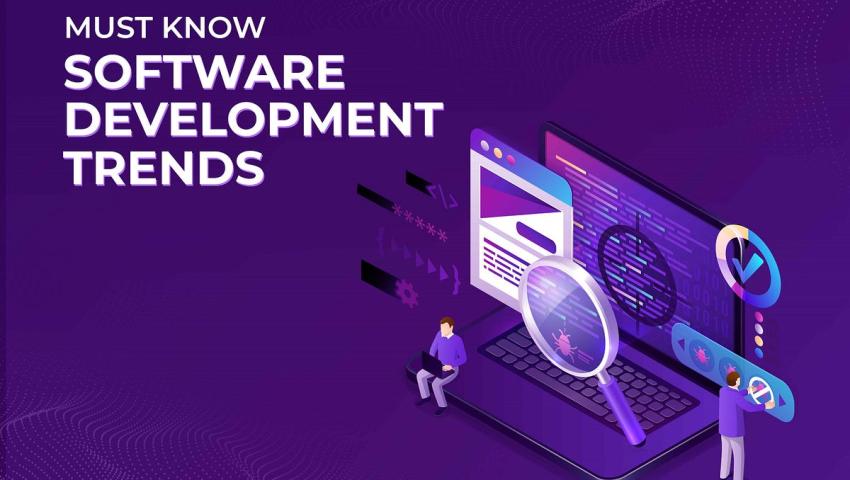
Top 10 Software Development Trends in 2025 You Need to Know
Stay ahead of the curve! Explore the top 10 software development trends for 2025 that will shape the future of tech. Learn how to innovate and grow your business.
Staying ahead in software development means embracing the future. In 2025, trends like AI integration, cloud-native development, and low-code platforms will redefine how we build, scale, and innovate. Is your business ready for the next generation of software solutions?“ Feel free to use this as an impactful quote for social media or other promotional content!
The world of software development is evolving at a rapid pace, and staying ahead of the trends is essential for both developers and businesses. As we approach 2025, new technologies and methodologies are reshaping the way we create, deploy, and scale software. In this blog, we’ll explore the top 10 software development trends that will drive innovation in the coming year and beyond.
Whether you're a developer looking to stay competitive or a business owner wanting to leverage the latest advancements, these trends will help you understand what's next for software development.
1. AI and Machine Learning Integration
Artificial Intelligence (AI) and Machine Learning (ML) continue to revolutionize the software development process. In 2025, AI will play an even bigger role in automating repetitive tasks, improving testing, and enabling smarter applications. Developers will increasingly rely on AI-powered tools to enhance productivity and accuracy, whether through predictive analytics or automated debugging systems.
Why it matters: AI and ML will help software companies streamline workflows, reduce development time, and create smarter, more intuitive applications that meet user needs.
2. Cloud-Native Development
Cloud-native development is becoming the new norm as businesses move their operations to the cloud. With containerization technologies like Docker and Kubernetes, developers can build scalable, flexible, and high-performance applications faster than ever. This trend will continue to grow in 2025 as companies seek greater efficiency and reliability in their software infrastructure.
Why it matters: Cloud-native apps offer greater scalability, resilience, and easier management, which is essential for businesses looking to scale quickly while minimizing downtime.
3. DevOps Automation
DevOps practices are evolving, and automation is at the heart of this transformation. Continuous Integration (CI) and Continuous Delivery (CD) pipelines will become more automated, allowing teams to deliver software faster and with fewer errors. In 2025, expect automation to permeate every stage of the software lifecycle, from code deployment to monitoring and security.
Why it matters: Automated DevOps processes enhance collaboration, reduce human error, and accelerate time-to-market, ensuring faster delivery of high-quality software.
4. Low-Code and No-Code Development
Low-code and no-code platforms are democratizing software development by allowing non-developers to create applications without writing complex code. These platforms are expected to grow rapidly in 2025, enabling businesses to rapidly prototype and deploy applications, reducing dependency on traditional development teams.
Why it matters: These tools empower businesses to innovate faster, cut development costs, and reduce the time it takes to bring new ideas to life.
5. Edge Computing
Edge computing allows data processing closer to where it is generated, reducing latency and improving speed for applications. As IoT devices and remote work continue to rise, edge computing will become crucial in 2025. This technology ensures real-time data processing, making it ideal for applications that require instant action, such as autonomous vehicles or industrial automation.
Why it matters: Edge computing helps businesses reduce bandwidth costs, enhance application performance, and improve security by processing sensitive data locally.
6. Blockchain for Software Security
Blockchain technology is not just for cryptocurrencies. In 2025, more industries will adopt blockchain for securing software applications, ensuring data integrity, and preventing cyberattacks. Blockchain provides a decentralized, tamper-proof ledger, making it an ideal solution for industries like finance, healthcare, and logistics.
Why it matters: Blockchain enhances transparency and security, helping businesses protect sensitive data and reduce the risk of data breaches or fraud.
7. 5G and Mobile Development
With 5G networks becoming more widespread in 2025, mobile app development will experience a significant boost. 5G offers ultra-fast internet speeds, lower latency, and improved connectivity, making it possible to build more responsive and data-heavy mobile applications. Developers will need to optimize apps for 5G networks to take full advantage of this technology.
Why it matters: 5G will enable faster mobile experiences, improve gaming and streaming apps, and open new possibilities for IoT-connected devices.
8. Quantum Computing
While still in its early stages, quantum computing is a field that is rapidly advancing. In 2025, software developers will start exploring how quantum computing can solve complex problems that traditional computers can’t. Industries like finance, healthcare, and logistics will benefit from the potential of quantum algorithms for optimization and predictive modeling.
Why it matters: As quantum computing matures, it will allow businesses to solve previously impossible problems and unlock new innovations that weren’t feasible before.
9. Cybersecurity and Privacy by Design
With growing concerns over data breaches and cyber threats, cybersecurity and privacy will become more critical in 2025. The shift toward “privacy by design” means integrating privacy features directly into the software development process rather than adding them as an afterthought. Security features like end-to-end encryption, multi-factor authentication, and data anonymization will be built into applications from the start.
Why it matters: Stronger security and privacy measures will protect users’ data and help businesses comply with regulations like GDPR, ensuring trust and reducing the risk of breaches.
10. Serverless Computing
Serverless computing allows developers to build and run applications without having to manage the underlying infrastructure. In 2025, serverless platforms will continue to gain popularity due to their scalability, cost-effectiveness, and ease of use. This model is especially beneficial for small teams looking to deploy applications quickly and efficiently.
Why it matters: Serverless computing offers a more efficient way to build scalable applications while reducing infrastructure management overhead and costs.
Conclusion
The software development landscape is changing rapidly, and the trends listed above are just the beginning of what’s to come in 2025. By embracing these trends, developers can stay competitive, and businesses can continue to innovate and grow in the digital age.
Are you ready to adapt to these changes? Contact us today to learn how we can help you leverage these trends to transform your business and create cutting-edge software solutions.
Stay ahead of the curve! Subscribe to our newsletter for the latest insights, updates, and best practices in software development. We’ll help you navigate the future of technology with ease.



